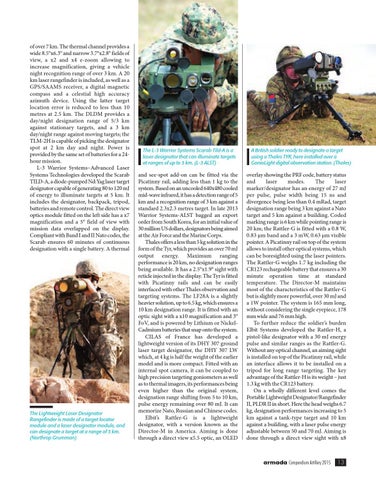of over 7 km. The thermal channel provides a wide 8.5°x6.3° and narrow 3.7°x2.8° fields of view, a x2 and x4 e-zoom allowing to increase magnification, giving a vehicle night recognition range of over 3 km. A 20 km laser rangefinder is included, as well as a GPS/SAAMS receiver, a digital magnetic compass and a celestial high accuracy azimuth device. Using the latter target location error is reduced to less than 10 metres at 2.5 km. The DLDM provides a day/night designation range of 5/3 km against stationary targets, and a 3 km day/night range against moving targets; the TLM-2H is capable of picking the designator spot at 2 km day and night. Power is provided by the same set of batteries for a 24hour mission. L-3 Warrior Systems–Advanced Laser Systems Technologies developed the Scarab TILD-A, a diode-pumped Nd:Yag laser target designator capable of generating 80 to 120 mJ of energy to illuminate targets at 5 km. It includes the designator, backpack, tripod, batteries and remote control. The direct view optics module fitted on the left side has a x7 magnification and a 5° field of view with mission data overlapped on the display. Compliant with Band I and II Nato codes, the Scarab ensures 60 minutes of continuous designation with a single battery. A thermal
The Lightweight Laser Designator Rangefinder is made of a target locator module and a laser designator module, and can designate a target at a range of 5 km. (Northrop Grumman)
The L-3 Warrior Systems Scarab Tild-A is a laser designator that can illuminate targets at ranges of up to 5 km. (L-3 ALST)
and see-spot add-on can be fitted via the Picatinny rail, adding less than 1 kg to the system. Based on an uncooled 640x480 cooled mid-wave infrared, it has a detection range of 5 km and a recognition range of 3 km against a standard 2.3x2.3 metres target. In late 2013 Warrior Systems-ALST bagged an export order from South Korea, for an initial value of 30 million US dollars, designators being aimed at the Air Force and the Marine Corps. Thales offers a less than 5 kg solution in the form of the Tyr, which provides an over 70 mJ output energy. Maximum ranging performance is 20 km, no designation ranges being available. It has a 2.5°x1.9° sight with reticle injected in the display. The Tyr is fitted with Picatinny rails and can be easily interfaced with other Thales observation and targeting systems. The LF28A is a slightly heavier solution, up to 6.5 kg, which ensures a 10 km designation range. It is fitted with an optic sight with a x10 magnification and 3° FoV, and is powered by Lithium or NickelCadmium batteries that snap onto the system. CILAS of France has developed a lightweight version of its DHY 307 ground laser target designator, the DHY 307 LW which, at 4 kg is half the weight of the earlier model and is more compact. Fitted with an internal spot camera, it can be coupled to high precision targeting goniometers as well as to thermal imagers, its performances being even higher than the original system, designation range shifting from 5 to 10 km, pulse energy remaining over 80 mJ. It can memorize Nato, Russian and Chinese codes. Elbit’s Rattler-G is a lightweight designator, with a version known as the Director-M in America. Aiming is done through a direct view x5.5 optic, an OLED
A British soldier ready to designate a target using a Thales TYR, here installed over a GonioLight digital observation station. (Thales)
overlay showing the PRF code, battery status and laser modes. The laser marker/designator has an energy of 27 mJ per pulse, pulse width being 15 ns and divergence being less than 0.4 mRad, target designation range being 3 km against a Nato target and 5 km against a building. Coded marking range is 6 km while pointing range is 20 km; the Rattler-G is fitted with a 0.8 W, 0.83 µm band and a 3 mW, 0.63 µm visible pointer. A Picatinny rail on top of the system allows to install other optical systems, which can be boresighted using the laser pointers. The Rattler-G weighs 1.7 kg including the CR123 rechargeable battery that ensures a 30 minute operation time at standard temperature. The Director-M maintains most of the characteristics of the Rattler-G but is slightly more powerful, over 30 mJ and a 1W pointer. The system is 165 mm long, without considering the single eyepiece, 178 mm wide and 76 mm high. To further reduce the soldier’s burden Elbit Systems developed the Rattler-H, a pistol-like designator with a 30 mJ energy pulse and similar ranges as the Rattler-G. Without any optical channel, an aiming sight is installed on top of the Picatinny rail, while an interface allows it to be installed on a tripod for long range targeting. The key advantage of the Rattler-H is its weight – just 1.3 kg with the CR123 battery. On a wholly different level comes the Portable Lightweight Designator/Rangefinder II, PLDR II in short. Here the head weighs 6.7 kg, designation performances increasing to 5 km against a tank-type target and 10 km against a building, with a laser pulse energy adjustable between 50 and 70 mJ. Aiming is done through a direct view sight with x8
Compendium Artillery 2015
13
